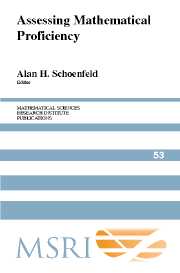Book contents
- Frontmatter
- Contents
- Preface
- Acknowledgments
- Section 1 The Big Picture
- Section 2 Perspectives on Mathematical Proficiency
- Section 3 What Does Assessment Assess? Issues and Examples
- Section 4 The Case of Algebra
- Section 5 What Do Assessments Assess? The Case of Fractions
- Section 6 The Importance of Societal Context
- Epilogue: What Do We Need to Know? Items for a Research Agenda
- About the Authors
- Subject Index
- Author Index
- Task Index
Section 1 - The Big Picture
Published online by Cambridge University Press: 06 July 2010
- Frontmatter
- Contents
- Preface
- Acknowledgments
- Section 1 The Big Picture
- Section 2 Perspectives on Mathematical Proficiency
- Section 3 What Does Assessment Assess? Issues and Examples
- Section 4 The Case of Algebra
- Section 5 What Do Assessments Assess? The Case of Fractions
- Section 6 The Importance of Societal Context
- Epilogue: What Do We Need to Know? Items for a Research Agenda
- About the Authors
- Subject Index
- Author Index
- Task Index
Summary
This introductory section establishes the context for what follows in this volume. In broad-brush terms, it does so by addressing three P's: pragmatics, philosophy, and policy.
Alan H. Schoenfeld opens with a discussion of pragmatics in Chapter 1. A simple question frames his contribution: Who wants what from mathematics assessments? As he shows, the issue is far from simple. It is true that at some level everyone involved in mathematics testing is interested in the same basic issue: What do students know? However, various groups have very different specific interests. For example, a teacher may want to know what his or her particular students need to know in order to improve, while a state superintendent may be most interested in trends and indications of whether various performance gaps are being closed. Other groups have other interests. Those interests are not always consistent or even compatible. Understanding who has a stake in assessment, and what different groups want to learn from it, is part of the big picture—the picture that is elaborated throughout the volume, as representatives of different stakeholder groups describe the kinds of information that they need and that carefully constructed assessments can provide. Schoenfeld also looks at the impact of assessment. Tests reflect the mathematical values of their makers and users. In the United States, tests are increasingly being used to drive educational systems—to measure performance aimed at particular educational goals.
- Type
- Chapter
- Information
- Assessing Mathematical Proficiency , pp. 1 - 2Publisher: Cambridge University PressPrint publication year: 2007



